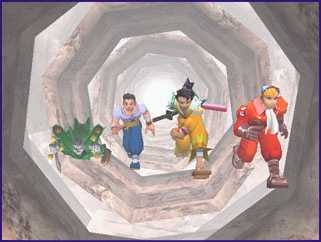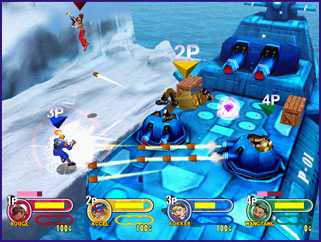Power Stone 2
Review - the most innovative and entertaining beat-em-up Capcom have ever made? We think so..

Furthering the genre
Another month, another Capcom beat-em-up. Anyone would think the buying public would be getting sick of the damn things. Over the last few months we've seen the progression of the Marvel vs. Capcom and Street Fighter lines, and even an updated version of Star Gladiator for crying out loud. A cursory glance at Capcom's back catalogue shows titles such as Rival Schools, Pocket Fighter and many more. One wonders how they can get away with it. The simple answer, as I'm sure you know by now, is that Capcom are great at what they do. With Street Fighter, they brought the genre to the forefront of arcade gaming. Over the years they've refined, redefined and added to the fighting game repertoire in a way Rare and Nintendo rejuvenated the platform game with Super Mario 64, and EA the sports game. For me, the fruit of all this effort is Power Stone 2. Original, quirky and devilishly fun, Power Stone 2 takes the traditional fighter, turns it on its head, and is a great game for it. If you play this, your judgement of fighters could be changed too. Of course, if you've never played the game, you'll be wondering what the hell I'm babbling about. I'd better start explaining. The story behind the game is as follows. It's the 19th century, and a group of adventurers are searching for the mystical, elusive Power Stones; gems of great magical power that can make any wish come true. One day, dark clouds form in the sky, and a huge hovering fortress emerges from the mists, its shadow darkening the whole world. The nefarious Dr. Erode resides within, and his collection of captured power stones. Nobody knows what he plans to use them for, but each one of the adventurers feels they must embark on a journey to his castle to retrieve the power stones, each for their own personal motive.

Stoned to death
The adventurers are a varied and charismatic bunch, featuring well-loved stereotypes and a few original ideas. Ranging from the obligatory big, beefy type to the tiny, geeky robotics freak, with a few madcap ideas such as the evil clown Jack and the mad chef Gourmand, the range of personas on show each have their own clearly identifiable traits and moves. A surprisingly large amount of characters appear throughout the game, complementing the variety in gameplay. At its core, the gameplay is manic fighting action for between 2 and 4 contenders. However, none of your hell-for-leather smacking each other with high punches, blocking low kicks and insane combos here. What we have is an ingenious system using only one Attack button, a Jump button, a drop item button, and a multifarious do-all button called Action. This action button allows items to be picked up, crates to be lifted, players to be grabbed and a whole lot more. The numerous boxes and crates that litter each stage are packed full of items, health boosters and the occasional power stone. The items available range from umbrellas and crowbars to huge bazookas and magic wands. The Action button even allows to you manipulate the landscape and architecture of each stage. "Architecture? Landscape?" I hear you cry. I'm not talking about the identical square fighting rings of the Tekken series or the 2D backdrops favoured by SNK. I mean truly interactive, interesting environments for the insane posse of scrappers to leap around in. Initially I was put off by the relatively few number of levels available but after playing just one, I had changed my mind. From the ice-breaking watercraft, to an elaborate airship, to a mystical Mayan-esque temple, to a futuristic space station, each level has its own features and quirks. In the Japanese castle level, for example, the initial fighting area, strewn with boxes and shields for your pleasure, quickly catches fire, leaving it to our four heroes to bound up platforms to the safety of the roof. It really lends more to Mario than to Mortal Kombat. In the Airship level, the flying contraption, due to the wear and tear of a few hyperactive polygons smacking each other around, quickly exploded, leaving our heroes to skydive (still kicking the living snot out of each other) to the castle below, where among the delights waiting are a man-made waterfall, and a fully operational tank.

Powerful stuff
There're even turrets and pillars to shoot and hit each other with on some levels. Gone are the days of punch-block-punch, because here we have punch-smash-shoot-hide-behind-pillar-jump-run. The design is genius. Not only genius, but beautiful: the 3D is of a quality that is excellent, even for the Dreamcast. Each and every element is crafted in bold, bright and shockingly fine detail. Whatever they're feeding the graphic artists at Capcom: more of it, please! Of course, mindless violence can quickly get boring, so thoughtfully Capcom have supplied us with many playing modes for our aggressive pleasure. From the obligatory fight your way through Arcade mode (with stages interspersed by 'boss' levels, where you destroy a huge enemy alongside your opponent), we have a Versus mode, a free-for-all Original (where up to 4 human or CPU opponents lay the smack down), and the epic Adventure mode. For the solitary player, Adventure mode is great. The aforementioned items are, this time round, stored in the magnificently named "Item Book". This hefty tome has hundreds of pages, but only a few dozen (!) items are actually available in game. How are the remainder of the pages filled? This is where the shopkeeper Mel comes in. Not only does this merchant of destruction buy and sell your assorted junk, she also has the Item Combiner: a machine dedicated to taking 2 of the items or essence cards (base substances, e.g. Fire, for making flamethrowers) to produce a whole new one. For example, the manual lists a Hand Grenade and a Rabbit Arm make a pair of Punching Gloves, and the ones you can devise yourself or learn about in-game are even zanier. During my last session, I successfully crossbred an Umbrella with an Axe, a bar of Gold with a Bazooka, and many more. This mode, in addition to the crazy fighting, gives longevity and challenge.

Friendly Rivalry
However, it's not the undoubted joys of the 1-player game that will keep you coming back. The multiplayer mode is undoubtedly the finest feature in the game. On the Dreamcast, at least, there's nothing to compare with smacking your mates across the face with crowbars while avoiding the strafed fire of a machine gun. Better still, finding 3 power stones then morphing into your character's Transformation (ranging from a giant phoenix to a smirking lizard) and blasting the hell out of everything. All of this is backed by a soundtrack of the highest order; a huge array of tracks and styles fit right in, changing as you fight your way through a level. The only possible downside to this game is that once you complete the Adventure mode, unless you have instant access to 3 other people at all times, it can get a little repetitive. But if you're fortunate enough to be amazingly popular, or live with people who adore games, this will seldom be out of your Dreamcast.
Conclusion
Superb, anarchic fun from Capcom. Puts some of their earlier offerings to shame. (Don't buy Marvel vs. Capcom 2!) If you've been looking for the perfect multiplayer game on the Dreamcast, or just a beat-'em-up with a hint of originality, you must get this. Be warned: I'm told it takes a certain kind of person to enjoy it. But the reaction I've seen from almost everyone who plays it basically says: if you like fun games, you'll love Power Stone 2.







